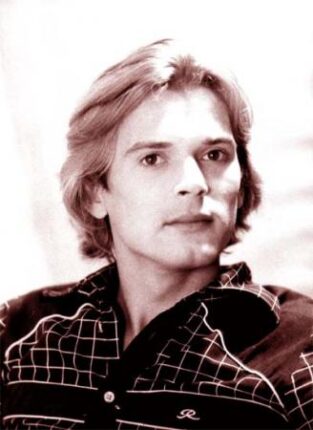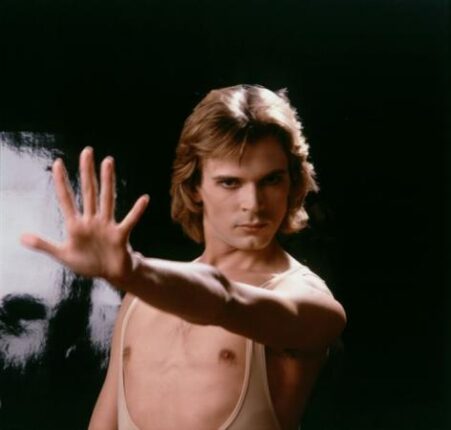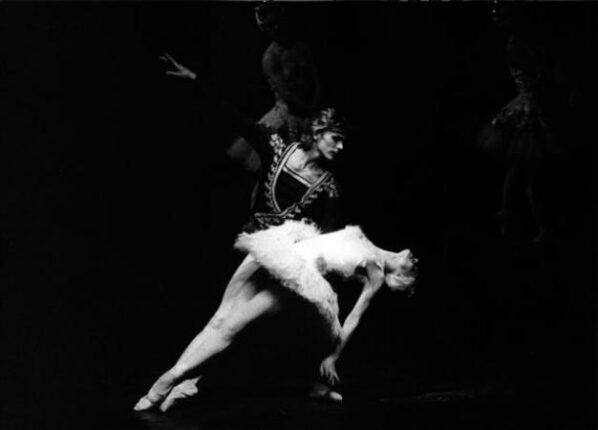Waldemar Wołk-Karaczewski – Polish dancer, teacher and choreographer, born 8 October 1954 in Ciechanów.
In 1964-1973, he studied at the Warsaw Ballet School. In 1971, he made his debut at the Teatr Wielki (Grand Theatre) in a duo with Anna Białecka in the ballet Don Quixote. He was a pupil of Zygmunt Dąbrowski and Raissa Kuzniecowa-Szajewska. During his diploma concert he danced the ballet miniature The Tempest with the choreography by his own teacher, Kuzniecowa-Szajewska.
After graduating he danced for the Song and Dance Ensemble ‘Mazowsze’, with which he toured Poland, Spain, the USSR, Greece, France, Brazil and Argentina. In 1975, he became a soloist at the Teatr Wielki, promoted to principal dancer in 1977. As a soloist dancing for the Teatr Wielki he made his debut in the role of Poet in the ballet La Sylphide. He subsequently danced principal roles in the ballets Stanisław i Anna Oświecimowie (choreographed by W. Gruca), Phaedra (choreographed by S. Lifar) and The Afternoon of a Faun (choreographed by S. Lifar). He partnered such Polish ballerinas as Maria Krzyszkowska, Ewa Głowacka and Elżbieta Jaroń, as well as the American ballerina Jeanette Vondersaar in Stefan Wenta’s Polish television film Maria Luiza. As a guest dancer with the ballet of the Teatr Wielki he performed in Łódź, Moscow (Bolshoi Theatre), Minsk and Bucharest (1976), and in a duo with Barbara Rajska also at the Fifth International Ballet Festival in Havana and Varadero (1976), as a guest dancer in Giselle in Poznań (1977), Donetsk and Kharkov (1979) as well as at the Intervision concert (1977). In 1978, he was the runner-up at the Second World Ballet Competition in Tokyo, where he partnered Ewa Głowacka. As a duo, they won the eighth place, but Waldemar Wołk-Karaczewski was favourite with the Japanese audience.
Upon the invitation from Maurice Béjart, he was a soloist at the Ballet of the 20th Century for the 1979/80 season, when he danced a number of prominent roles, also together with the outstanding female dancer Natalia Makarova. Béjart saw him as a danseur étoile, the equivalent of the term danseur noble, with which Waldemar Wołk-Karaczewski has been identified ever since. In John Neumeier’s ballet Love and Pain and the World and the Dream, he shared the main role with Jorge Donn. After a year, he quit Maurice Béjart’s company, declined an offer from John Neumeier and returned to Warsaw, where his engagements, however, proved to be infrequent. In 1981, he took his family and went to West Berlin, where he was offered principal dancer at the Deutsche Oper Berlin, thus being the first Pole to dance the main role of Apollo in the ballet Apollo (choreographed by G. Balanchine), and where he danced with the prima ballerina Eva Evdokimova. Together they danced Giselle in Warsaw in 1988. He remained in West Berlin until 1983 and subsequently, until the middle of 1989, he was principal dancer in the ballet of the State Bavarian Opera in Munich. From 1987, he was a guest dancer at the Teatr Wielki in Warsaw. He performed worldwide with the Polish ballet and the German companies. He officially concluded his stage career in 1989, but he continued working as a guest dancer with the Astra Roma Ballet, for which he also made his initial choreographies. As a choreographer, he also collaborated with the Teatr Wielki in Warsaw, Polski Teatr Tańca (Polish Dance Theatre) in Poznań and Teatr Wielki (Grand Theatre) in Poznań.
After concluding his stage career, the artist also began work on film documentaries. He cooperated with a Munich-based agency commissioned by the Bavarian television. He is a professional film and television cinematographer. However, in 2004 he quit his work as a cinematographer, returned to Poland and settled in the town of Legnica, where one of his activities involves running a ballet studio at the Legnica Cultural Centre.
The most notable roles in Waldemar Wołk-Karaczewski’s career include Albert (Giselle, choreographed by J. Coralli, J. Perrot, edited by A. Gridin, I. Mikhailichenko), Siegfried (Swan Lake, choreographed by A. Gorski, A. Messerer, edited by B. Chaliułow), Prince (Sleeping Beauty, choreographed by M. Petipa, edited by P. Wright), Franz (Coppélia, choreographed by Jose Pares), Prince (The Nutcracker in choreographic versions by Nureyev and Neumeier), Poet (La Sylphide, choreographed by M. Fokine), Colas (La Fille mal gardée, choreographed by Jose Pares), Romeo (Romeo and Juliet choreographed by J. Cranko), Onegin (Onegin choreographed by J. Cranko), Apollo (Apollon Musagète choreographed by G. Balanchine), as well as solo parts in M. Bejart’s ballets: Actus tragicus, Light, The Firebird, Ce que la Mort me dit, The Rite of Spring and Gaîté parisienne, in addition to solos in the ballets by B. Cullberg, R. Hynd, K. Jooss, S. Lifar, K. MacMillan, H. Konwiński, H. van Manen, V. Nebrada, J. Neumeier, R. Nureyev, V. Panov, M. Pendleton, P. Schaufuss, T. Schilling, A. Tudor, N. Vesak and P. Wright.
His own choreographies include Maria (music by L. Bernstein, Astra Roma Ballet, 1988), Daphnis (music by M. Ravel, Teatr Wielki in Warsaw, 1989), The Nutcracker (music by P. Tchaikovsky, Astra Roma Ballet, 1989, with Diana Ferrara), Compte à rebours (music by Georges Delerue, Astra Roma Ballet, 1990), Coronation Mass (music by W.A. Mozart, Polski Teatr Tańca, 1990), Muzy Chopina (music by F. Chopin, Teatr Wielki in Warsaw) and Hrabia Monte Christo (music by S. Moniuszko, Teatr Wielki im. Moniuszki in Poznań, 2005).
In 2019, the Towarzystwo Miłośników Ziemi Ciechanowskiej, an organisation promoting the region of Ciechanów, where the artist comes from, published an album dedicated to him, Waldemar Wołk-Karaczewski our danseur noble, edited by Paweł Chynowski.







